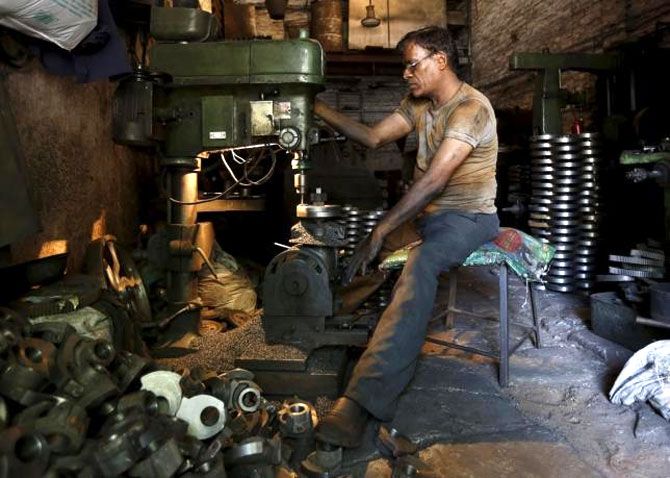The growing use of contract workers reflects a significant informalisation of the workforce in India's organised manufacturing sector, and raises concerns about the sustainability of employment growth, note Radhicka Kapoor and P P Krishnapriya.
 The employment structure of India's organised manufacturing sector has undergone substantial changes over the last decade, with a steep rise in the use of contract workers.
The employment structure of India's organised manufacturing sector has undergone substantial changes over the last decade, with a steep rise in the use of contract workers.
The share of contract workers in total employment increased from 15.7 per cent in 2000-01 to 26.5 per cent in 2011-12, while that of regular workers declined commensurately from 61.1per cent to 51.5 per cent in the same period.
The growing use of contract workers - workers who are hired on short-term contracts and can be fired easily - reflects the significant informalisation of the workforce in the organised sector and raises concerns about the sustainability of employment growth.
The recurring labour unrest witnessed in factories such as Maruti Suzuki's Manesar factory in July 2012, where 40 per cent of the workers were contract workers, is reflective of a deep-rooted labour crisis.
There exists a vast literature which attributes the widespread use of contract labour to India's rigid employment protection legislation, in particular Chapter VB of the draconian Industrial Disputes Act (IDA), which makes it necessary for firms employing more than 100 workers to obtain the permission of state governments to retrench workers.
However, the argument that it is inflexible labour regulations that have incentivised firms to substitute regular workers with contract workers deserves closer scrutiny for several reasons. First, labour regulations have not become more rigid over the time period when contract worker intensity has surged.
Second, even states which made amendments to their labour laws to make them more amenable to employers have witnessed a sharp increase in contract worker usage.
Third, it is capital-intensive and not labour-intensive industries, where pro-labour regulations hurt the most, which have seen a larger increase in contract worker usage.
And finally, if firms were hiring contract workers only to circumvent legislation such as IDA, we should have observed the highest intensity of contract worker usage across firms which hired less than 100 workers.
However, the largest share of contract workers is in fact seen in firms hiring more than 300 workers.
This reiterates the fact that firms are clearly induced to hire contract workers for reasons other than rigidities in labour regulations.
Contract workers are significantly cheaper, performing the same task as regular workers.
Over the last decade, real wages paid to regular workers have on average been one-and-a-half times those of contract workers.
Not only are wages paid to contract workers relatively low as compared to regular workers, but they also do not enjoy social security cover under different legislative provisions.
The savings thus made by firms increase profitability and therefore motivate firm owners to hire contract workers.
Furthermore, the presence of contract workers in a firm's workforce helps the firm's management diminish the bargaining power of regular workers and exerts downward pressure on their wages, as contract workers act as an alternative workforce which they can use to their strategic advantage against unionised regular workers.
That the real wages of regular workers have in fact stagnated over the last decade (2000-2012) is suggestive of this.
Empirical evidence from enterprise-level data from India's organised manufacturing sector confirms that the share of contract workers has a statistically significant positive effect on firm profitability.
It is worth noting that during the last decade, the share of profits in total gross value added for the manufacturing sector has increased sharply from 19.9 per cent ( 2000-01) to 46.2 per cent (2011-12), while that of wages paid to workers has declined steeply from 22.2 per cent to 14.3 per cent over the same period. Of course, it could be argued that it is capital augmenting technological progress which has driven these trends.
However, our empirical analysis suggests that even after controlling for technological progress, it is the substitution of regular workers with contract workers which has an overwhelming effect on firm profitability.
This is also indicative of the adverse effect contractualisation has on the distribution of income in the manufacturing sector.
Given that it is largely the profit motive that is driving firms' decisions to hire contract workers and not just the need to retain greater flexibility in labour use, the proposal to amend the Contract Labour Act, to bring contract workers on a par with regular workers, is indeed a step in the right direction.
This is imperative even to protect the interests of regular workers who are experiencing increasingly vulnerable terms of employment as the contract worker pool expands.
Moreover, given that contractualisation tends to disincentivise workers from investing in skills, as returns on their investment may not translate into higher wages, such a move is likely to address barriers to skill development.
From a firm's standpoint, such a move may result in a significant escalation of the wage bill in the short run. However, it may well have positive implications on productivity and consequently profitability in the long run.
This in fact raises the larger question of whether it is indeed appropriate to encourage the practice of creating jobs which pay low wages and lack job security simply to preserve profits in the short run.
Importantly, given that the unorganised sector anyway accounts for a disproportionately large share of employment in the manufacturing sector (over 90 per cent), the increasing informalisation of the organised sector will certainly not help India address the challenge of productive job creation.
Radhicka Kapoor and P P Krishnapriya are with ICRIER, New Delhi









